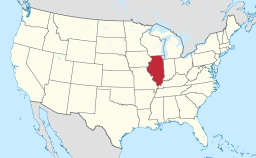Matteson, Illinois
| Village of Matteson | |
| Village | |
| Motto: Matteson, the Crossroads of Heritage and Progress | |
| Country | United States |
|---|---|
| State | Illinois |
| Counties | Cook, Will |
| Coordinates | 41°30′35″N 87°44′21″W / 41.509832°N 87.739267°WCoordinates: 41°30′35″N 87°44′21″W / 41.509832°N 87.739267°W |
| Area | 9.36 sq mi (24.24 km2) |
| - land | 9.32 sq mi (24 km2) |
| - water | 0.03 sq mi (0 km2), 0.32% |
| Population | 19,009 (2010) |
| Density | 2,039.6/sq mi (787.5/km2) |
| Incorporated | 1889 |
| Mayor | Andre' B. Ashmore |
| Timezone | CST (UTC-6) |
| - summer (DST) | CDT (UTC-5) |
| Postal code | 60443 |
| Area code | 708 |
|
Location in Cook County and the state of Illinois.
|
|
|
Location of Illinois in the United States
|
|
|
Website: www |
|
Matteson /ˌmætɪsən/ is a village in Cook and Will counties, Illinois, United States. The population was 12,928 at the 2000 census and 19,009 in 2010.
The area encompassed by modern Matteson was settled in the mid 1800s, primarily by people of German descent. Platted in 1855, Matteson had nearly 500 residents when it incorporated as a village in 1889. The village's namesake is Joel Aldrich Matteson, who served as Illinois' tenth governor from 1853 to 1857. The 20th century saw improvements in plumbing, the electrification of the Illinois Central Railroad, and the construction of today's school district, resulting in significant population growth to more than 3,000 residents by the end of the 1960s. By 2000, Matteson was home to Lincoln Mall (opened 1973) and annexed 195 acres of land for the village.
For most of its history, Matteson's population was majority white. However, by the 2010s, the village became majority African-American. The director of Chicago Metropolis 2020, Carol Sonnenschein, stated that the desire for higher quality neighborhoods and public schools drove the black influx into Matteson. In 1980, 8,288 residents were white, comprising 84% of the village's population, while 12% of village residents were black. By 1990, Matteson, with a total of 11,400 residents, had 5,687 white residents, making up 53% of the village, a percentage decline of 31% in a ten-year span; 44% of the total number of residents in Matteson were black. By 1995 48% of the residents were black and 45% were white. In 2010, 78.72% of the residents were black and 16.3% of the residents were white.
In 1995 Matteson officials started a campaign encouraging white homeowners to buy houses in the village. Some Matteson residents, white and black, did not want their communities to become overwhelmingly black and lose racial diversity. The Chicago branches of the NAACP and some other black residents criticized the campaign, arguing it was racist. Some other critics stated that the blacks moving to Matteson were wealthier than the whites they replaced.
...
Wikipedia



